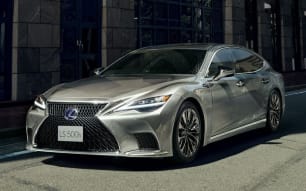Value, refinement and customer care are Lexus' traditional brand pillars.
Lexus broke through with recession-ravaged consumers at the dawn of the 1990s by firstly presenting an attractively conservative S-Class sized sedan at smaller E-Class prices, and then adding an uncannily hushed cabin of exquisite build quality, silky V8 performance, the entire kitchen sink of gadgetry and unheard-of ownership privileges, like tickets to events, free parking at selected venues and home/work vehicle pick-up at service time.
If such a strategy worked then, why not an expanded version now? After all, while sales started off slowly in Australia three decades ago, in the vital US market its impact was immense. Lexus eventually gained traction locally, but nowadays the LS lags significantly behind the leading S-Class; in 2020, it managed a three per cent share compared to Mercedes' 25.5 per cent – or just 18 registrations versus 163.
Sadly, the V8s haven't returned, but the facelift does bring a richer interior with high-quality materials to elevate comfort levels, backed up by redesigned seating and overhauled adaptive suspension dampers that also promote a cushier ride while not compromising steering/handling performance.
Meanwhile, new ambient lighting and (at last) touch-display capability for the 12.3-inch central screen and Apple CarPlay/Android Auto connectivity do at least play catch up with the rest of the industry, let alone its direct rivals.
The same applies with the fresh safety gains for the series that include a digital rear-view mirror, Lexus Connected Services (with automated collision notification, SOS call and vehicle tracking), Intersection Turning Assist (that helps keep the driver from turning into on-coming traffic or brakes the car if, whilst turning, a pedestrian crosses the road), far-broader functionality of the autonomous emergency braking systems (including greater rear-cross-traffic warning and intervention), full-speed stop/go adaptive cruise control with traffic flow capability, improved road-sign recognition, better lane-keep and assist tech and a next-gen adaptive high beam tech dubbed BladeScan with stronger lighting and anti-glare performance parameters.
These come on top of the standard adaptive dampers, height-adjustable rear air suspension, front/rear cross-traffic alert, sunroof, gesture-activated powered boot lid, soft-close doors, puddle lights, 23-speaker premium audio, digital radio, DVD player, head-up display, satellite navigation, climate control with infrared body temperature sensitivity, heated/vented front and rear outboard seating, powered seats with memory, heated steering wheel, electric rear blind and a four-camera surround-view monitor.
The F Sport from $195,953 differs from the Sport Luxury from $201,078 (both before on-road costs) with its 10 airbags, dark 20-inch alloys and exterior trim hues, brake-package boost, rear-wheel steering, variable gear ratio, unique instrumentation and dark-metallic interior themes and bolstered front seats, while the LS 500 adds active anti-roll bars front and rear.
Going Sports Luxury changes things up somewhat, with two extra airbags (rear-seat cushion items), special noise-reduced alloys, rear-zone climate control, Semi Aniline leather, a front-seat relaxation system, rear-seat tablet-style screens, powered reclinable heated/vented rear seats with ottoman and massage, rear centre armrest with touchscreen climate/multimedia control, side sunshades and – in LS 500 only – a rear cooler box.
On the owner-benefit front, ‘Encore Platinum' introduced last year builds on the regular Encore's valet servicing with benefits like free use of a Lexus for business or leisure travel within select Australian and now-New Zealand destinations (one-way only – sorry, Kiwis) for up to four times annually and lasting the first three years of ownership. There's also eight yearly free valet parking at certain shopping malls and other venues, several celebrity-laden social events/activities and discounted Caltex fuel.
With all these features as standard, the LS costs several tens of thousands of dollars less than most full-sized luxury sedan rivals with broadly similar performance outputs and optioned up with equivalent luxuries, before the Encore Premium privileges. However, while the Lexus' four-year/100,000km warranty also betters most competitors by one year, it is mileage capped while others' regimes aren't, and none beat Mercedes' five-year/unlimited program.
Though prices are up by nearly $2000, it's fair to conclude the extra kit and improvements help offset them, but it's also worth remembering that earlier last year, Lexus hiked LS prices by up to nearly $4000, and not too long before Encore Platinum was announced...

